I had timed my launch for the afternoon slack tide; it was a late start, but at midday the ebb pouring through Rosario Strait would have been running against me at close to 3 knots. There were 18 miles to go to reach Matia, Sucia, and Patos, three small islands that crown Washington state's San Juan archipelago, but I’d make good speed with the flood in my favor and my 2.5-hp, four-stroke outboard pushing HESPERIA, a 17′ camp cruiser I'd designed and built. My course paralleled the undulations of Cypress Island’s west shore up to the cusp at Tide Point and there I began a diagonal crossing of the strait to Orcas Island. In the open water the tide was with me but the wind was not and as light as it was, it still made a mess of the water. All around the buoy at Buckeye Shoal the waves were as ragged as rasp teeth. It wasn’t the kind of water that agrees with HESPERIA’s pram bow and shallow-V forward sections. At first I took just a bit of spray over the bow so I just partially unfolded FAERIE—my 4′8″ collapsible, coracle-like tender—like a dodger to keep myself dry. I soon retreated through the cabin to get my weight out of the bow and steered standing in the open hatch. It was still an uncomfortable ride so I veered west toward a bit of flat water on the downstream side of North Peapod, the largest of a cluster of rocks a half mile out from Orcas. I considered abandoning my plan and seeking the more sheltered waters between Orcas, Blakely, Lopez and Shaw Islands but just north of Lawrence Point there was an end to the chop.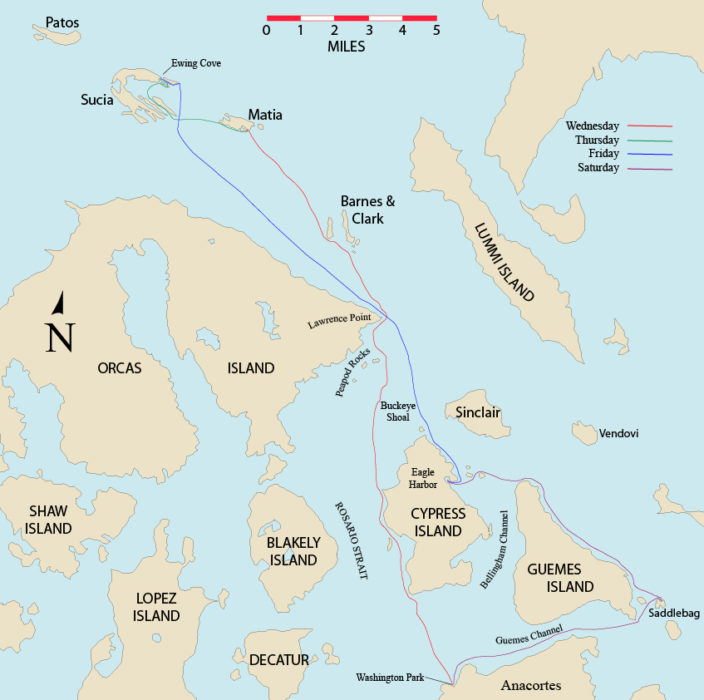 Passing within 75 yards of Little Sister, a ragged islet bare but for a few patches of wind-shorn scrub, I steered between mushrooming boils and dimpled eddies toward Barnes Island. Beyond Barnes, the four-mile crossing to Matia offered smoother waters that slipped docilely under the bow. I didn’t turn on my GPS to check my speed; the overlapping hills of Orcas Island showed HESPERIA was making progress and that was enough: There was plenty of daylight left, I was where I wanted to be, and it didn’t matter how fast I was going. Matia and Sucia were drawing near while behind me the Cascade mountain range, a dusty blue deckle edge spanning the eastern horizon, was flattened and faded by distance.
Passing within 75 yards of Little Sister, a ragged islet bare but for a few patches of wind-shorn scrub, I steered between mushrooming boils and dimpled eddies toward Barnes Island. Beyond Barnes, the four-mile crossing to Matia offered smoother waters that slipped docilely under the bow. I didn’t turn on my GPS to check my speed; the overlapping hills of Orcas Island showed HESPERIA was making progress and that was enough: There was plenty of daylight left, I was where I wanted to be, and it didn’t matter how fast I was going. Matia and Sucia were drawing near while behind me the Cascade mountain range, a dusty blue deckle edge spanning the eastern horizon, was flattened and faded by distance.
Join The Conversation
We welcome your comments about this article. To include a photo with your remarks, click Choose File below the Comment box.

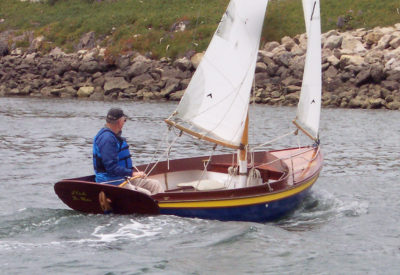
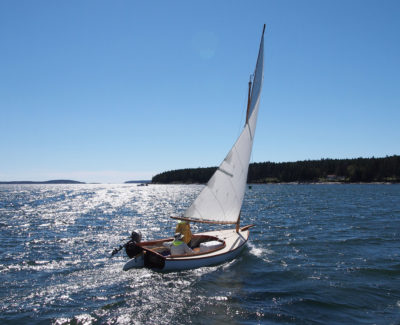

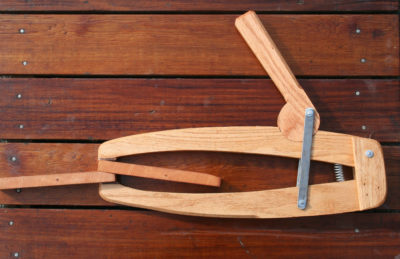
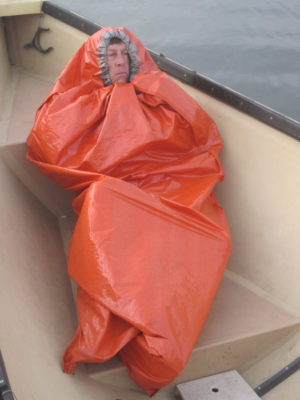
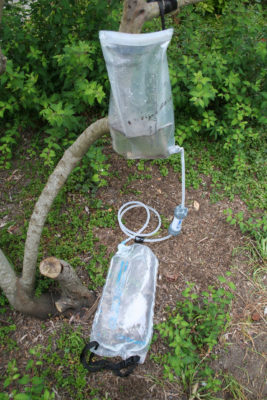
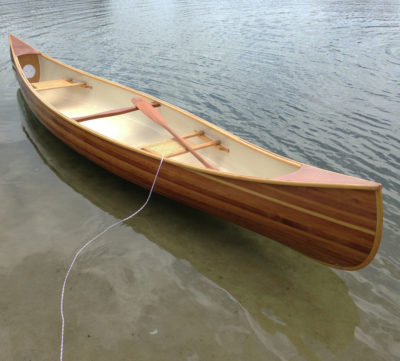
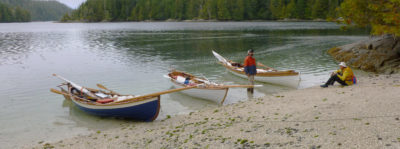
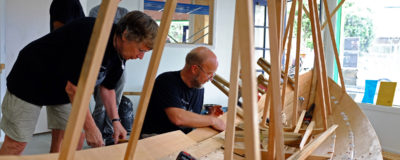
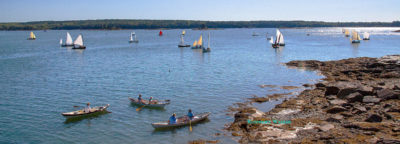

Very interesting from many points of view! I have much experience doing similar trips in the outer islands of the Abaco Islands in the Bahamas. I admire your boat and the thoughts in design and using her. Good Luck!
Great article, fine craft, and a wonderful inspiration for a host of small coastal cruising craft. Thanks, it was worth my subscription in one article as encouragement in small boats.
A delightful read, Christopher. This wonderful cruise reminds me of the Will Rogers quotation: “Good judgment comes from experience, and a lot of that comes from bad judgment.” It seems you are at the age of using your experience to make a comfortable sail which to someone of lesser experience would lead to stories of near death and the I-had-to-hang-on-for-dear-life ilk. Love the pictures, the videos (too short) and the wry humor. Great encouragement to the beginning gunkholer, also.
Thanks, Mark. I had a few hang-on-for-dear-life experiences in my earlier cruises and came away from at least two of them well aware that I’d been lucky to survive. I occasionally took pictures of myself as reminders of how miserable and scared I had been at times, but even so I took pride in my adventures, i.e. mishaps and miseries, and in pushing my limits. I eventually got over that.
I like your style! It is indicative of your well presented Small Boats Monthly, a publication I enjoy.
I don’t mind saying that from the first time I saw this boat I have been enamored with it. Having seen it up close, it opened up a lot of possibilities to me and has made me want to try my hand at building something along those lines. I have to face the fact though that my other boats must be finished before I start a new project, which is OK because it gives me a lot of sketch time. Your article is a good balance between the boat and a long San Juan weekend—great motivation to get those other boats done soon! You can bet this article will go in my files with the other HESPERIA info. Thanks!
Awesome. I loved it. I personally would have liked a companion but hey, some people like their own company too.
HESPERIA was, from the start, meant for two. As I mentioned in the side bar, Rachel and I had previously made the cruise to Matia and Sucia and we’ll be taking the boat other places in the future. The quarters are a little tight when making the conversions in the cabin for sitting, dining, and sleeping, but after the furniture has been rearranged there’s plenty of room for two.
Your boat, coracle, and all accessories are an interesting, efficient, well thought-out combination of “stuff-that-works”. Well done.
On a different plane, the use of videos in this magazine format is excellent. The coracle paddling video was especially effective at showing something that would be difficult to explain in words.
Harlan Hubbard would be proud!
As we say here in the back waters of Slower Lower Delaware, NEVER LOST but Most Often ADRIFT!
I’m honored by your mention of Harlan Hubbard. I’d read Harlan’s book Shantyboat: A River Way of Life when I was preparing to row a sneakbox down the Ohio and Mississippi Rivers in the winter of 1985. As I approached Cincinnati I pulled off the river at Brent, Kentucky, at the spot where Harlan built the shantyboat that he and his wife Anna used to drift to the Mississippi River Delta. I stopped at a house nearby to see if people still remembered the Hubbards. The woman I spoke with said, much to my surprise, that the Hubbards were both still alive (Harlan was then 85 and died in 1988; Anna was then 83 and died in 1986) and living at Payne Hollow farther down river. I stopped at Payne Hollow and hit a rock coming ashore, putting a gouge in my boat’s hull. I introduced myself to the Hubbards and upon hearing that I needed to make repairs to my boat, they kindly offered to let me stay while I fixed the boat and spend the night in their home. They were among the most gracious people I’ve ever met and my brief visit with them is one I will never forget.
What a brilliant concept! Where can the plans for the boat and the coracle be obtained?
Thanks for your interest in plans. Both boats grew out of dozens of sketches I made in my notebooks and while I’ve thought a lot about drawing up plans, at this point I haven’t taken on that project.
Excellent and interesting article Mr. Cunningham. I’d like to know more about your centerboard configuration. Also, what with the rainy weather you have up that way is your cockpit self bailing? The videos of HESPERIA under sail made me feel as though I was there, and wanted to be.
Thanks, Davi. The centerboard and its trunk are fairly ordinary. The trunk is roughly rectangular and its height was determined by the height of the side benches. It occupies a bit of space on the starboard side in both the cockpit and the cabin, but because its port face is part of the bench-support panel, there’s no sign of it. The forward end of the board is a half circle with a groove cut into it to cradle the haul-down line. An auto-release clam cleat allows the board to kick up if it hits an obstruction (or if I forget to pull the board up when I approach the haul-out ramp—the event that moved me to get such a cleat in the first place).
The cockpit is not self-bailing. I have a pair of holes in one of the floorboards sized to take the bilge pump I carry. I bought more fabric to enclose the cockpit when I’m at anchor with the canopy in place, but I haven’t been motivated to do that project yet. The HESPERIA was designed with wet-weather cruising capability, but during the rainy seasons in the Puget Sound area, the boating isn’t much fun.
A spork?! Why… that’s outrageous, man! 😉
Very fun article and wonderful boat and adventures. Thanks!
This article reminds me of several things. First, how much I enjoyed the article when I first read it. I was finishing building a Garvey then and I wished I had read the article before I built the Garvey. HESPERIA inspires many fun and practical ideas in the designing/building process, as well as using it. Raising the roof is as simple as it is brilliant, but I would never have thought of it. Second, building boats is what gives me pleasure, but actually using the boats hasn’t interested me at all. So far. But this article makes me want to re-evaluate the wisdom in that thinking. Third, I’m reminded how much important good stuff I forgot since I read it the first time. Rerunning articles is quite valuable to those of us who are a little short on memory cells. And perhaps most important, this article is one of many that show how extraordinarily worthy/skillful/knowledgeable/experienced/inspirational our author/editor is to us subscribers (and freeloaders).
Thank you so much, CC!
What paint or coating did you use on Hesperia when you built her. Builders seldom comment on the coatings they’ve used on wooden boats unless it was ‘glassed